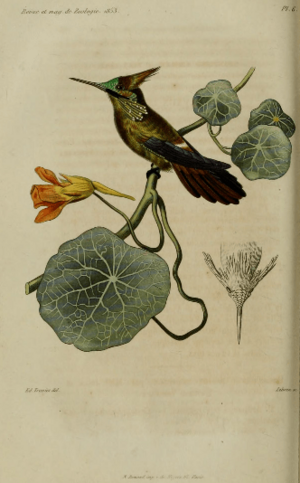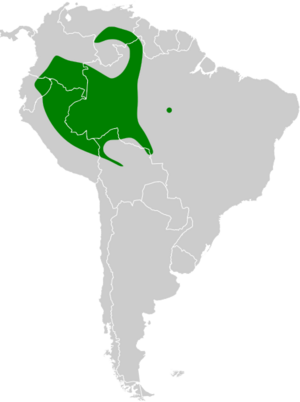Butterfly coquette facts for kids
Quick facts for kids Butterfly coquette |
|
|---|---|
 |
|
| Conservation status | |
| Scientific classification | |
| Genus: |
Lophornis
|
| Species: |
verreauxii
|
 |
|
The butterfly coquette (Lophornis verreauxii) is a tiny, colorful hummingbird. It's part of a group of hummingbirds called "coquettes." You can find this amazing bird in several South American countries, including Bolivia, Brazil, Colombia, Ecuador, Peru, and Venezuela.
Contents
How Scientists Classify This Bird
Scientists group living things based on their features. This is called taxonomy. The butterfly coquette used to be considered a type of festive coquette. But in recent years, experts decided it was different enough to be its own separate species! This change was made by important bird groups like the South American Classification Committee (SACC) and the International Ornithological Committee (IOC).
There are two main types, or subspecies, of the butterfly coquette:
- L. v. verreauxii (the most common type)
- L. v. klagesi
What the Butterfly Coquette Looks Like
This little bird is about 7.5 to 9.1 centimeters (3 to 3.5 inches) long. That's about the length of your finger!
The male butterfly coquette is very fancy:
- It has a deep green head with a long, green crest that has red tips.
- It also has long green "whiskers" with white tips on its cheeks.
- Its back is green with shiny golden spots.
- It has bright reddish feathers above its tail and a white band on its lower back.
- Its belly is green, but its thighs are white.
- Its tail is a pretty maroon color.
The female looks a bit different:
- She doesn't have the crest or the long "whiskers."
- She has a whitish patch on her cheek.
- Her reddish tail feathers are not as bright as the male's.
- She has golden highlights on her chest.
The L. v. klagesi subspecies is generally darker than the main type. Its tail feathers are more of a bronzy green.
Where the Butterfly Coquette Lives
The main subspecies, L. v. verreauxii, lives in the Amazon rainforest areas of Colombia, Ecuador, and Peru. It also spreads into Brazil and south into central Bolivia. The L. v. klagesi subspecies is found only in a specific river area in Venezuela called the Río Caura watershed.
These birds like to live in many different wet places, such as:
- Forests near rivers
- Forests with white sand
- Terra firme forests (which are tropical forests on higher, drier ground)
- Areas where forests are growing back after being cut down
- Bushy fields
They can be found at elevations up to 1,000 meters (about 3,300 feet) high.
How the Butterfly Coquette Behaves
Movement
The butterfly coquette usually stays in one area. However, scientists think it might move short distances during different seasons.
Feeding
This hummingbird mainly sips nectar from flowers. It often looks for nectar high up in the trees, but it will also feed closer to the ground. It usually hovers in front of flowers to drink. Sometimes, it will even poke a hole in the bottom of a flower to "steal" nectar without helping to pollinate the plant.
These birds are known for "trap-lining." This means they visit a regular route of flowering plants. They don't seem to guard their feeding areas, but they might argue with other hummingbirds if they both want to feed at the same flower patch. Besides nectar, they also eat tiny insects. They probably pick these insects off leaves.
Breeding
Scientists don't know much about how the butterfly coquette breeds. Its nests and eggs have not been described yet.
Vocalization
The butterfly coquette is usually quiet. But when it's feeding, it makes short "tsip" or "chip" sounds. You can even find an audio recording of its call online at Cornell University's Macaulay Library!
Conservation Status
The IUCN (International Union for Conservation of Nature) has listed the butterfly coquette as a species of "Least Concern." This means it's not currently in danger of disappearing. However, its exact population size isn't known, and scientists believe its numbers might be slowly going down. It lives in a few protected areas, but it's generally uncommon and spread out across its habitat.


